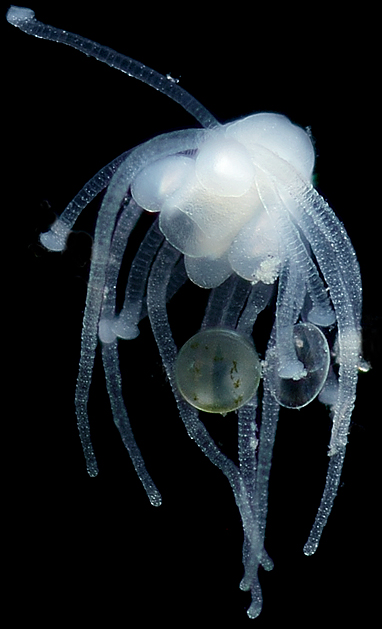Marsipohydra pacifica - a new interstitial meiobenthic HydrozoaIn the end of 2012 we described a new intersitial (living between sand grains) Hydrozoa species from East Kamchatka (NW Pacific) Marsipohydra pacifica. Externally this species has some resemblance with Otohydra and tentatively was assigned to the family Otohydridae although most probably is not related with Otohydra and its systematic position should be clarified in future. |
|
SANAMYAN, N., SANAMYAN K., 2012. New records of meiobenthic hydroids (Cnidaria: Hydrozoa)
from Far East Seas of Russia. Conservation of biodiversity of Kamchatka and coastal
waters : materials of ŐIII international scientific conference, dedicated to the 75th
anniversary of S.A. Dyrenkov's birthday. - Petropavlovsk-Kamchatsky : Kamchatpress, 2012 : 102-109.
To download full text click here.
AbstractA new genus and species of meiobenthic hydrozoa Marsipohydra pacifica gen. nov., sp. nov. is described from East Kamchatka (NW Pacific). It inhabits interstitial spaces between gravel particles at depth of 20-27 m. The whole exterior and morphology of the species resembles Otohydra vagans. The body and the tentacles are covered by cilia. The body with hemispherical or obtusely conical umbrella is about 0,2-0,3 mm high and 0,4-0,5 mm diameter. Umbrella has 8 small but rather distinct lobes. There is no subumbrellar cavity. A ring of 16 tentacles is around rather long (0.3 mm) manubrium. The tentacles are of two sorts, alternating with each other, 8 are shorter and have adhesive enlargement at their end, and 8 are longer and tapering. 16 statocysts are between the bases of the tentacles. The species is gonochoric, with well marked sexual dimorphism. Male specimens have 4 oval testes situated symmetrically on the wall of manubrium. Female specimens have a long (0,8-1,2 mm) brood pouch attached by one end to the lateral wall of manubrium near its base. On opposite end the brood pouch has terminal opening through which young and fully formed medusae are released. Brood pouch may contain 4-5 or probably more developing medusae. Newly bourn medusae are 0,3 mm long and have 8 tentacles, 4 of which have adhesive enlargements at the end. The new genus differs from Otohydra by being gonochoric, by position of developing embryos (inside the umbrella in Otohydra and in a long attached to manubrium and freely hanging down brood pouch in Marsipohydra gen. nov.). We plan to publish more detailed study of this species in future.Specimen on the photo on the right is a holotype (Ea-158, male, keept in Zoological Museum of Moscow State University). Below are photos of some specimens of Marsipohydra pacifica, note that male and female specimens are easily recognizable. Female specimens have a brood pouch with developing embryos attached to the side of manubrium and male specimens have four testicular follicles on manubrium. |

|

